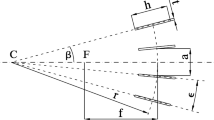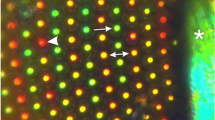Summary
The superposition eyes and simple eyes of many arthropods have apertures (A) with a diameter bigger than, or about the same size as, the focal length of the eye (f). That is, these eyes have low F-numbers (f/A). Many of the light rays focussed onto a photoreceptor will not be trapped by total internal reflection in the photoreceptor and will therefore pass through and be absorbed in photoreceptors other than that for which the light was intended. This spread of light in the retina leads to a broadening of the angular-sensitivity function and a consequent degrading of the image at the retinal level. A number of solutions to this problem are found in nature, with the most effective that of isolating the photoreceptors with a sheath of either light-absorbing pigment or reflecting tapetum. A ray-tracing model was used to assess the relative merits of the tapetal and pigment sheath designs in low F-number superposition eyes, and also to investigate the effect of changing the refractive index and absorption coefficient of the rhabdom. Which sheathing solution is best depends on the quality of the image on the retina, on the spacing of the rhabdoms in the retina and on the intensity of light normally experienced by the eye. In a retina with closely packed rhabdoms, the model predicts full sheathing to be the optimal solution if the image is well-focussed, partial sheathing if poorly focussed and no sheathing if moderately well-focussed. In a retina with rhabdoms spaced apart and a well-focussed image, the model predicts partial sheathing to be optimal. A pigment sheath is predicted to be useful in eyes which experience bright light and have no need for high sensitivity. A tapetal sheath is predicted to be useful at any intensity. A survey of arthropod eyes with low F-number supports the predictions of the model.
Similar content being viewed by others
References
Ball EE, Kao LC, Stone RC, Land MF (1986) Eye structure and optics in the pelagic shrimpAcetes sibogae (Decapoda, Natan- tia, Sergestidae) in relation to light-dark adaptation and natural history. Phil Trans R Soc Lond B 313:251–270
Blest AD (1985) The fine structure of spider photoreceptors in relation to function. In: Barth FG (ed) Neurobiology of arach- nids. Springer, Berlin Heidelberg New York, pp 79–102
Blest AD, Land MF (1977) The physiological optics ofDinopis subrufus L. Koch: a fish lens in a spider. Proc R Soc Lond B 196:197–222
Bruin GHP de, Crisp DJ (1957) The influence of pigment migration on vision of higher Crustacea. J Exp Biol 34:447–463
Bruno MS, Barnes SN, Goldsmith TH (1977) The visual pigment and visual cycle of the lobsterHomarus. J Comp Physiol 120:123–142
Bryceson KP, McIntyre P (1983) Image quality and acceptance angle in a reflecting superposition eye. J Comp Physiol 151:367–380
Bursey CR (1975) The microanatomy of the compound eye ofMunida irrasa (Decapoda, Galatheidae). Cell Tissue Res 160:505–514
Caveney S, McIntyre P (1981) Design of graded-index lenses in the superposition eyes of scarab beetles. Phil Trans R Soc Lond B 294:589–632
Denton EJ, Nicol JAC (1964) The chorioidal tapeta of some car- tilaginous fishes (Chondrichthyes). J Mar Biol Assoc UK 44:219–258
Doujak FE (1985) Can a shore crab see a star? J Exp Biol 166:385–393
Dubs A (1982) The spatial integration of signals in the retina and lamina of the fly compound eye under different conditions of luminance. J Comp Physiol 146:321–343
Dumont JPC, Robertson RM (1986) Neuronal circuits: an evolu- tionary perspective. Nature 233:849–853
Fischer A, Horstmann G (1971) Der Feinbau des Auges der Mehl- motteEphestia kühniella Zeller (Lepidoptera, Pyralididae). Z Zellforsch 116:275–304
Gokan N (1982a) The compound eye of the soybean beetle,Anomala rufocuprea Motschulsky (Coleoptera, Scarabaeidae). Appl Entomol Zool 17:227–237
Gokan N (1982b) The fine structure of the compound eyes ofMaladera orientalis andParaserica grisea (Coleoptera, Scarabaeidae). Kontyu 50:330–343
Gokan N (1989) The compound eye of the dung beetleGeotrupes auratus (Coleoptera, Scarabaeidae). Appl Entomol Zool 24:133–146
Gokan N, Meyer-Rochow VB, Nagashima T (1987) Fine structure of the compound eye of the skin beetleTrox mitis (Coleoptera, Scarabaeidae). Kontyu 55:587–600
Hallberg E (1977) The fine structure of the compound eyes of mysids (Crustacea, Mysidacea). Cell Tissue Res 184:45–65
Hallberg E, Nilsson DE (1983) The euphausiid compound eye — a morphological re-investigation (Crustacea, Euphausiacea). Zoomorphology 103:59–66
Hardie RC, Duelli P (1978) Properties of single cells in posterior lateral eyes of jumping spiders. Z Naturforsch 33c:156–158
Horridge GA (1969) Unit studies on the retina of dragonflies. Z Vergl Physiol 62:1–37
Horridge GA (1972) Further observations on the clear zone eye ofEphestia. Proc R Soc Lond B 181:157–173
Horridge GA (1976) The ommatidium of the dorsal eye ofCloeon as a specialization for photoisomerization. Proc R Soc Lond B 193:17–29
Horridge GA, Duelli P (1979) Anatomy of the regional differences in the eye of the mantisCiulfina. J Exp Biol 80:165–190
Horridge GA, Giddings C (1971a) Movement on dark-light adapta- tion in beetle eyes of the neuropteran type. Proc R Soc Lond B 179:73–85
Horridge GA, Giddings C (1971b) The retina ofEphestia (Lepidop- tera). Proc R Soc Lond B 179:87–95
Horridge GA, McLean M (1978) The dorsal eye of the mayflyAtalophlebia (Ephemeroptera). Proc R Soc Lond B 200:137–150
Horridge GA, Giddings C, Stange G (1972) The superposition eye of skipper butterflies. Proc R Soc Lond B 182:457–495
Horridge GA, McLean M, Stange G (1977) A diurnal moth super- position eye with high resolutionPhalaenoides tristifica (Agaris- tidae). Proc R Soc Lond B 196:233–250
Horridge GA, Marcelja L, Jahnke R (1982) Light guides in the dorsal eye of the male mayfly. Proc R Soc Lond B 216:25- 51
Horridge GA, Marcelja L, Jahnke R (1983a) Retinula cell responses in a moth superposition eye. Proc R Soc Lond B 220:47–68
Horridge GA, Marcelja L, Jahnke R, McIntyre P (1983b) Daily changes in the compound eye of a beetle(Macrogyms). Proc R Soc Lond B 217:265–285
Kampa EM (1963) The structure of the eye of a galatheid crus- tacean,Pleuroncodes planipes. Crustaceana 6:69–84
Kirschfeld K (1974) The absolute sensitivity of lens and compound eyes. Z Naturforsch 29c:592–596
Kunze P (1979) Apposition and superposition eyes. In: Autrum H (ed) Vision in invertebrates (Handbook of sensory physiology, vol. VII/6A). Springer, Berlin Heidelberg, New York, pp 441–502
Land MF (1969) Structure of the retinae of the principal eyes of jumping spiders (Salticidae, Dendryphantinae) in relation to visual optics. J Exp Biol 51:443–470
Land MF (1972) The physics and biology of animal reflectors. Prog Biophys Mol Biol 24:75–106
Land MF (1978) Animal eyes with mirror optics. Sci Am 239:126–134
Land MF (1981) Optics and vision in invertebrates. In: Autrum H (ed) Vision in invertebrates (Handbook of sensory physiology, vol. VII/6B). Springer, Berlin Heidelberg New York, pp 471–592
Land MF (1984) The resolving power of diurnal superposition eyes measured with an ophthalmoscope. J Comp Physiol A 154:515–533
Land MF, Burton FA, Meyer-Rochow VB (1979) The optical geometry of euphausiid eyes. J Comp Physiol 130:49–62
Loew RE (1976) Light, and photoreceptor degeneration in the Norway lobster,Nephrops norvegicus (L.). Proc R Soc Lond B 193:31–44
McIntyre P, Caveney S (1985) Graded-index optics are matched to optical geometry in the superposition eyes of scarab beetles. Phil Trans R Soc Lond B 311:237–269
Meinecke CC (1981) The fine structure of the compound eye of the African armyworm moth,Spodoptera exempta Walk. (Lepidoptera, Noctuidae). Cell Tissue Res 216:333–347
Meyer-Rochow VB (1973) The dioptric system of the eye ofCybister (Dytiscidae, Coleoptera). Proc R Soc Lond B 183:159–178
Meyer-Rochow VB (1974) Fine structural changes in dark-light adaptation in relation to unit studies of an insect compound eye with a crustacean-like rhabdom. J Insect Physiol 20:573–589
Meyer-Rochow VB (1975) Larval and adult eye of the western rock lobster(Panulirus longipes). Cell Tissue Res 162:439–457
Meyer-Rochow VB (1978) Retina and dioptric apparatus of the dung beetleEuoniticellus africanus. J Insect Physiol 24:165–179
Meyer-Rochow VB, Horridge GA (1975) The eye ofAnoplognathus (Coleoptera, Scarabaeidae). Proc R Soc Lond B 188:1–30
Miskimen GW, Rodriguez NL (1981) Structure and functional aspects of the scotopic compound eye of the sugarcane borer moth. J Morphol 168:73–84
Nilsson DE (1989) Optics and evolution of the compound eye. In: Stavenga DG, Hardie RC (eds) Facets of vision. Springer, Berlin Heidelberg New York, pp 30–73
Nilsson DE, Howard J (1989) Intensity and polarization of the eyeshine in butterflies. J Comp Physiol A 166:51–56
Nilsson DE, Nilsson HL (1981) A crustacean compound eye adapted for low light intensities (Isopoda). J Comp Physiol 143:503–510
O'Carroll D (1989) An optical assessment of visual performance in the eyes of hunting spiders (Araneae, Labidognatha). PhD thesis, The Flinders University of South Australia, Australia
Seitz G (1968) Der Strahlengang im Appositionsauge vonCalliphora erythrocephala (Meig.). Z Vergl Physiol 59:205–231
Shimohigashi M, Tominaga Y (1986) The compound eye ofParnara guttata (Insecta, Lepidoptera, Hesperiidae): fine structure of the ommatidium. Zoomorphology 106:131–136
Tuurala O (1954) Histologische und physiologische Untersuchungen über die photomechanischen Erscheinungen in den Augen der Lepidopteren. Ann Acad Sci, Fenn Series A 24:1–69
Varela FG, Wiitanen W (1970) The optics of the compound eye of the honeybee(Apis mellifera). J Gen Physiol 55:336–358
Warrant EJ, McIntyre PD (1990) Limitations to resolution in superposition eyes. J Comp Physiol A 167:785–803
Welsch B (1977) Ultrastruktur und functionelle Morphologie der Augen des NachtfaltersDeilephila elpenor (Lepidoptera, Sphingidae). Cytobiologie 14:378–400
Williams DS (1982) Ommatidial structure in relation to photoreceptor membrane turnover in the locust. Cell Tissue Res 225:595–617
Williams DS (1983) Changes of photoreceptor performance associated with the daily turnover of photoreceptor membrane in the locust. J Comp Physiol 150:509–519
Williams DS, McIntyre PD (1980) The principal eyes of a jumping spider have a telephoto component. Nature 288:578–580
Wilson M, Garrard P, McGinness S (1978) The unit structure of the locust compound eye. Cell Tissue Res 195:205–226
Yagi N, Koyama N (1963) The compound eye of Lepidoptera. Maruzen and Co. (agents for Shinkyo-Press and Co., Ltd.), Tokyo
Zyznar ES (1970) The eyes of white shrimp,Penaeus setiferus (Linnaeus) with a note on the rock shrimp,Sicyonia brevirostris Stimpson. Contrib Mar Sci 15:87–102
Author information
Authors and Affiliations
Rights and permissions
About this article
Cite this article
Warrant, E.J., McIntyre, P.D. Strategies for retinal design in arthropod eyes of low F-number. J Comp Physiol A 168, 499–512 (1991). https://doi.org/10.1007/BF00199610
Accepted:
Issue Date:
DOI: https://doi.org/10.1007/BF00199610




